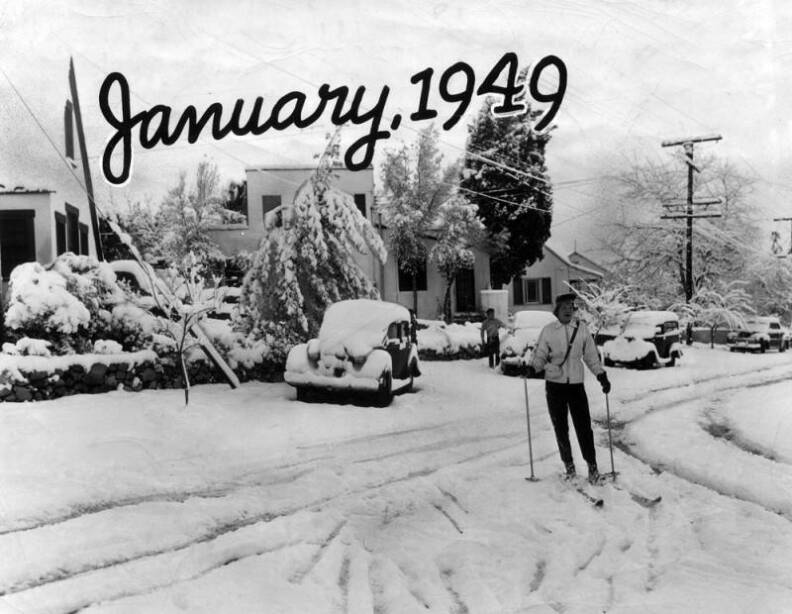A Brief History Of Why It Does Occasionally Snow In LA. Even Near The Hollywood Sign

You could say it’s snow joke in Los Angeles County, and this time that terrible pun may hold up.
The weather is expected to be so wild in the next few days that yes, snow is on the radar in elevations much lower than usual.
It’s a rarity to get weather like this — in the land known for everlasting sunshine and balmy beach trips — but snow has happened before outside the mountains and foothills.
Let’s look at L.A.’s past run-ins with snowfall.
Notable winter slurries
Whenever snow falls close to our low-lying cities, it’s a big event. Even trace amounts capture our attention. But if you’re talking about a decent covering — a record snowfall — you have to go back a few decades, according to the L.A. Almanac and National Weather Service.
January 1949 was the primetime for snowfall. Pasadena got about 3 inches (3 inches!), and so did Van Nuys. Burbank saw multiple inches that year. Even downtown L.A. wasn’t spared from the abnormally cold weather, with snow speckling the ground.

Don't miss the classic narration on this news report from 1949:
That's a palm tree and, yes, that's snow!
Snow fell for four consecutive days. The Rose Bowl was described as a “dishpan full of milk” and a snowman appeared in Eagle Rock with a sombrero, according to the L.A. Times.
For kids raised on palm trees and sunshine, it was a gleeful time, with inner tubes, sleds and snow fights in the streets.
From 1873 to today
The year 1957 left behind the delightful top photo from a snowy pool in the San Fernando Valley, as well as this show of Southern California resilience in the face of inclement weather at an open house in Encino.

The above report on snow at lower elevation has this note for Dec. 16, 1987: "Snow fell for two minutes at Malibu Beach." Also noted, the following day: "Disneyland was closed due to the weather for only the second time in 24 years."
In 1991 the LAX airport received a dusting. Trace amounts have come down in Westwood in 2013 and Palmdale in 2016. Santa Clarita, near higher elevated areas, got two inches in 2011. And parts of Southern California got a dusting in 2019.
Did it really snow this week at the Hollywood sign?
The National Weather Service says yes, with a small hedge. [Graupel = soft, small pellets of supercooled water droplets that generally disintegrate when handled.]
After a little investigating and with the help of the ALERT CA cameras, we are confident in saying snow or graupel fell on Mt. Lee (where the Hollywood sign sits) this morning around 9:15 am. #CAsnow #socal #CAweather #LosAngelesweatherhttps://t.co/SlKSGdAVTe pic.twitter.com/T3XYY47oge
— NWS Los Angeles (@NWSLosAngeles) February 24, 2023
What areas are more likely to get snow?
Snowfall often happens in places that are more remote. The San Gabriel Mountains, for example, are regular recipients. Lisa Phillips, a meteorologist with the National Weather Service, said snowfall can expand into more populated areas too.
“Normally, our snow is confined to L.A. County mountain areas,” Phillips said. “But sometimes, it can kind of creep into the Antelope Valley. It’s not unheard of for it to come down to Granada Hills.”
That L.A. neighborhood typically has a lower chance because its elevation is at just around 1,000 feet. By contrast, Palmdale and Lancaster can get pelted with ice because they sit at about 2,500 feet.
Since elevation is one of the key factors for snowfall, the closer you are to sea level, the more likely it is to be too warm for snow to form. That means L.A.’s icy dreams have centered around hail — when raindrops start to freeze in an updraft wind flow.
Phillips said we need a more widespread cold system like the one we’re getting now to get actual snow, which L.A. County doesn’t see that often.
How can I find out my area’s elevation?
Topographic maps can help you see elevation ranges. They’re like heat maps, but for height above the sea level. This weekend’s storm will bring snow between 1,500 and 5,000 feet, Phillips said. (Normally, snowfall starts between 3,000 and 7,000 feet, depending on the time of year). Most of L.A. County’s cities sit between 100 and 1,200 feet.
You can use this map to find out your elevation level.
-
Sandhill cranes are returning to the Lake Tahoe basin after a century long hiatus in what many say is a conservation success story.
-
Jackie’s partner, Shadow, refuses to abandon their unviable eggs, despite her attempts to nudge him along.
-
We do have some of the same types of buildings here.
-
Switching to an electric heat pump water heater can save you money and help the state avoid power outages.
-
The state's parks department is working with stakeholders, including the military, to rebuild the San Onofre road, but no timeline has been given.
-
Built in 1951, the glass-walled chapel is one of L.A.’s few national historic landmarks. This isn’t the first time it has been damaged by landslides.










